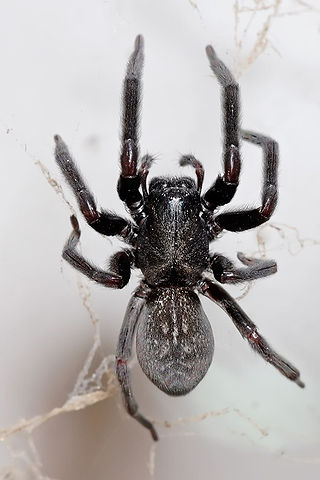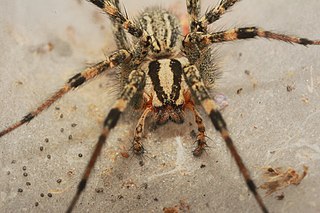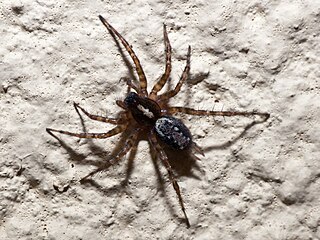
The hobo spider is a member of the family of spiders known colloquially as funnel web spiders, but not to be confused with the Australian funnel-web spider. Individuals construct a funnel-shaped structure of silk sheeting and lie in wait at the small end of the funnel for prey insects to blunder onto their webs. Hobo spiders sometimes build their webs in or around human habitations. Despite past claims, there is no clear evidence that the hobo spider has venom that is dangerous to humans.

The Agelenidae are a large family of spiders in the suborder Araneomorphae. Well-known examples include the common "grass spiders" of the genus Agelenopsis. Nearly all Agelenidae are harmless to humans, but the bite of the hobo spider may be medically significant, and some evidence suggests it might cause necrotic lesions, but the matter remains subject to debate. The most widely accepted common name for members of the family is funnel weaver.

The southern house spider is a species of large spider in the family Filistatidae. Currently given the scientific name Kukulcania hibernalis, it was formerly known as Filistata hibernalis. Found in the Americas, it exhibits strong sexual dimorphism. It lives in the southern states of the USA, throughout Central America and some of the Caribbean, to southern Brazil, Uruguay and Argentina. The males may be mistaken for brown recluse because the two have similar coloration and body structure. However, compared to the brown recluse, male southern house spiders are typically larger in size, lack the distinctive violin shape on their cephalothorax, and have unusually long slender pedipalps. The females are dark brown or black and more compact. Both sexes may grow to be roughly 2 inches (5.1 cm) across, with the males typically having longer legs, and the females often having larger, bulbous bodies. The abdomen of the southern house spider is covered with fine velvety light gray hair.

The spider species Tegenaria domestica, commonly known as the barn funnel weaver in North America and the domestic house spider in Europe, is a member of the funnel-web family Agelenidae.

The giant house spider has been treated as either one species, under the name Eratigena atrica, or as three species, E. atrica, E. duellica and E. saeva. As of April 2020, the three species view was accepted by the World Spider Catalog. They are among the largest spiders of Central and Northern Europe. They were previously placed in the genus Tegenaria. In 2013, they were moved to the new genus Eratigena as the single species Eratigena atrica. In 2018, the three separate species were restored. The bite of these species does not pose a threat to humans or pets, and they are generally reluctant to bite, preferring instead to hide or escape.

The woodlouse spider is a species of spider that preys primarily upon woodlice. Other common names refer to variations on the common name of its prey, including woodlouse hunter, sowbug hunter, sowbug killer, pillbug hunter and slater spider.

The black house spider or common black spider is a common species of cribellate Australian spider, introduced to New Zealand and Japan. A closely related species, Badumna longinqua, the grey house spider, has a similar distribution, but has also been introduced to the Americas.

Oecobius navus is a small cosmopolitan cribellate spider species found across the world.

Agelenopsis aperta, also known as the desert grass spider or funnel-web spider, is a species of spider belonging to the family Agelenidae and the genus Agelenopsis. It is found in dry and arid regions across the southern United States and into northwestern Mexico. Their body is about 13–18 mm long and they have relatively long legs in order to run after their prey. Desert grass spiders can withstand very low temperatures even though they do not cold harden. It constructs the characteristic funnel-shaped webs in crevices where the funnel will fit, where they wait in the tube for prey which they can run after using their long legs. They often hunt for their prey at night.

Titanoeca quadriguttata is a species of spider in the family Titanoecidae. It is widespread in Europe, though absent from Great Britain, and is found in Austria, Belgium, Bulgaria, Corsica, Croatia, Czech Republic, France, Germany, Greece, Hungary, Italy, Liechtenstein, Moldova, Russia, Slovakia, Spain, Switzerland, the Netherlands, Ukraine.

Metepeira labyrinthea, the labyrinth orbweaver, is a spider, with thin legs and a round, bulbous abdomen It is a member of the genus Metepeira in the family Araneidae. The female’s length is 5.3 mm, its carapace 2.3 mm, abdomen 3.3 mm, and extended legs 18.4 mm. The carapace is brown or gray, and the abdomen is dark with a white pattern. The legs alternate pale brown and dark brown, and the sternum is dark brown with a longitudinal yellow mark. The male spider is three-quarters of the female’s length, or slightly larger, with a darker carapace and with greater contrast between dark and light areas of the legs. Metepeira are easily distinguished from other Araneidae by their light eye region, white median line on the sternum, relative length of the leg segments, small male palpus, weakly sclerotized epigyne and the special composite web.

Spiders are air-breathing arthropods that have eight limbs, chelicerae with fangs generally able to inject venom, and spinnerets that extrude silk. They are the largest order of arachnids and rank seventh in total species diversity among all orders of organisms. Spiders are found worldwide on every continent except Antarctica, and have become established in nearly every land habitat. As of September 2024, 52,309 spider species in 134 families have been recorded by taxonomists. However, there has been debate among scientists about how families should be classified, with over 20 different classifications proposed since 1900.

Plexippus paykulli is a species of jumping spider. It is native to south east Asia but has spread to other parts of the world and globe. In the United States it is called the pantropical jumping spider. It is usually associated with buildings and may be found near light sources catching insects attracted by the light. It is named in honor of Gustaf von Paykull.

Menemerus bivittatus is a spider in the family Salticidae commonly known as the gray wall jumper. It is a pantropical species and is usually found on the walls of buildings or on tree trunks where it stalks its prey.

Agelena labyrinthica is a species of spider in the family Agelenidae. It is a widespread species in Europe and its range extends to Central and East Asia.

Portia schultzi is a species of jumping spider which ranges from South Africa in the south to Kenya in the north, and also is found in West Africa and Madagascar. In this species, which is slightly smaller than some other species of the genus Portia, the bodies of females are 5 to 7 mm long, while those of males are 4 to 6 mm long. The carapaces of both sexes are orange-brown with dark brown mottling, and covered with dark brown and whitish hairs lying over the surface. Males have white tufts on their thoraces and a broad white band above the bases of the legs, and these features are less conspicuous in females. Both sexes have tufts of orange to dark orange above the eyes, which are fringed with pale orange hairs. Males' abdomens are yellow-orange to orange-brown with blackish mottling, and on the upper sides are black and light orange hairs, and nine white tufts. Those of females are pale yellow and have black markings with scattered white and orange-brown hairs on the upper side. P. schultzi has relatively longer legs than other Portia, and a "lolloping" gait.
Atrax yorkmainorum is a venomous species of Australian funnel-web spider belonging to the Atracidae family and is found in forests in the vicinity of Canberra and south-eastern New South Wales. The genus Atrax was first documented in 1877 and the Atrax yorkmainorum species was first described in 2010.
Anelosimus jabaquara is a species of spider found in subtropical, humid, lowland forests in Brazil. Anelosimus jabaquara was first described by Herbert W. Levi in 1956. These spiders cooperate to spin and repair the colonial web, capture prey, and care for the brood. Colony size is small, and the sex ratio is biased towards females.

Textrix is a genus of funnel weavers first described by Carl Jakob Sundevall in 1833. They have a mainly European distribution, with one species in Ethiopia. The type species of the genus is Textrix denticulata.
Agelenopsis pennsylvanica, commonly known as the Pennsylvania funnel-web spider or the Pennsylvania grass spider, is a species of spider in the family Agelenidae. The common name comes from the place that it was described, Pennsylvania, and the funnel shape of its web. Its closest relative is Agelenopsis potteri.

















